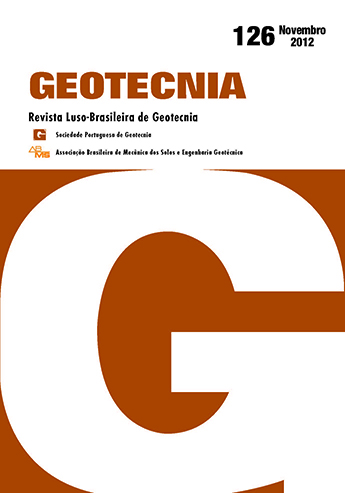Algorithm for modelling collapse in unsaturated soils
DOI:
https://doi.org/10.14195/2184-8394_126_1Keywords:
Unsaturated soils, Numerical modelling, Soil-structure interactionAbstract
Soil saturation may cause deformations, known as collapse deformations. The mechanism responsible for these collapse deformations in soils is the reduction to zero of the matric suction, which represents the effect of interparticle capillary forces. An algorithm specifically formulated to simulate collapse deformations is described in this work. The algorithm is then applied to the numerical analysis of settlement and damage on a masonry facade of a building, due to saturation of a zone in the foundation soil
Downloads
References
Alonso, E. E.; Gens, A.; Josa, A. (1990). A constitutive model for partially saturated soils. Géotechnique, vol. 40, pp. 405-430.
Bishop, A. W. (1959). The principle of effective stress. Teknisk Ukeblad, vol. 106 (39), pp. 859-863.
Duncan, J. M.; Chang, C. Y. (1970). Non-linear analysis of stress and strain in soils. J. Soil Mech. and Found. Div., ASCE, vol. 96 (SM5), pp. 1629-1654.
Farias, M. M. (1993). Numerical analysis of clay core dams. PhD Thesis, University College of Swansea.
Itasca Consulting Group, Inc. (2000). FLAC user’s guide, version 4. Minneapolis, Minnesota.
Liu, G.; Houlsby, G. T.; Augarde, C. E. (2000). Two-dimensional analysis of settlement damage to masonry buildings caused by tunneling. The Structural Engineer, vol. 79, nº 1, pp. 19-25.
Loret, B.; Khalili, N. (2002). An effective stress elastic-plastic model for unsaturated porous media. Mechanics of Materials, vol. 34, pp. 97-116.
Lourenço, P. B. (1996). Computational Strategies for Masonry Structures. PhD Thesis, Delft University of Technology.
Maranha, J. R. (1997). Analysis of Embankment Dams: Computational Aspects. PhD Thesis, University of Wales, Swansea.
Mourinha, A. M. S. (2010). Danos em edifícios devidos a assentamentos por colapso em solos não saturados. Dissertação de Mestrado (Bolonha), ISEL, Lisboa.
Nobari, E. S.; Duncan, J. M. (1972). Effect of reservoir filling on stresses and movements in earth and rockfill dams. Technical report, College of Engineering, University of California, Berkeley, Report No. TE-72-1 – Prepared for U.S. Army Engineer Waterways Experiment Station, Vicksburg, Mississipi.
Noorany, I., Frydman, S.; Detournay, C. (1999). Prediction of soil slope deformation due to wetting. In Detourney & Hart (eds.), FLAC and Numerical Modeling in Geomechanics, Balkema, Rotterdam.
Nuth, M.; Laloui, L. (2008). Effective stress concept in unsaturated soils: clarification and validation of a unified framework. International Journal for Numerical and Analytical Methods in Geomechanics, vol. 32, pp. 771-801.
Rodrigues, R. A. (2007). Modelação das deformações por colapso devidas à ascensão de lençol freático. Tese de Doutoramento, Escola de Engenharia de São Carlos, Universidade de São Paulo, Brasil.
Roscoe, K. H.; Burland, J. B. (1968). On the generalised stress-strain behaviour of ‘wet’ clay. In Heyman, J. e Leckie, F. A. (Eds.), Engineering Plasticity, Cambridge University Press, Cambridge, U. K., pp. 535-609.
Souza Neto, J. B. (2004). Comportamento de um solo colapsível avaliado a partir de ensaios de laboratório e campo, e previsão de recalques devidos à inundação (colapso). Tese de Doutoramento, Universidade Federal do Rio de Janeiro, Brasil.
Waltham, A. C. (1994). Foundations of Engineering Geology.Blackie Academic & Professional,




